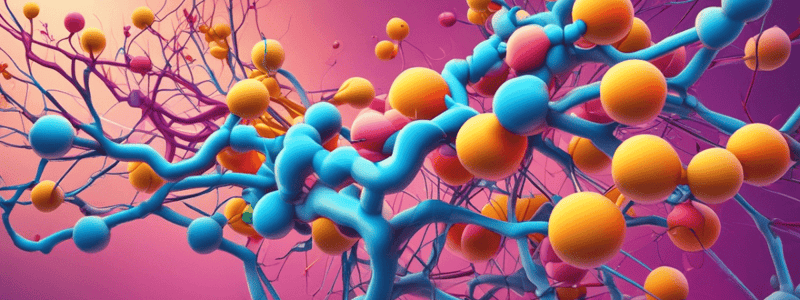Podcast
Questions and Answers
What is the primary purpose of the preparatory phase of glycolysis?
What is the primary purpose of the preparatory phase of glycolysis?
- To initiate the oxidation of the three-carbon units
- To produce four ATP molecules
- To convert glucose into two three-carbon units (correct)
- To regenerate NAD+ for glycolysis to continue
Which of the following is NOT a characteristic of the payoff phase of glycolysis?
Which of the following is NOT a characteristic of the payoff phase of glycolysis?
- It consumes two NADH (correct)
- It converts glucose into pyruvate
- It initiates the oxidation of the three-carbon units
- It produces four ATP molecules
What is the net yield of ATP per molecule of glucose converted to pyruvate in glycolysis?
What is the net yield of ATP per molecule of glucose converted to pyruvate in glycolysis?
- 2 ATP (correct)
- 6 ATP
- 4 ATP
- 8 ATP
Which of the following is a target of tight regulation in glycolysis?
Which of the following is a target of tight regulation in glycolysis?
Which of the following is a key step in the activation of the glycolytic pathway?
Which of the following is a key step in the activation of the glycolytic pathway?
What is the end product of the hydrolysis of lactose by the enzyme lactase?
What is the end product of the hydrolysis of lactose by the enzyme lactase?
Which of the following monosaccharides does NOT directly enter glycolysis?
Which of the following monosaccharides does NOT directly enter glycolysis?
What is the main purpose of the Cori cycle in the context of glycolysis?
What is the main purpose of the Cori cycle in the context of glycolysis?
Under what conditions is pyruvate reduced to lactate instead of being oxidized to acetyl-CoA?
Under what conditions is pyruvate reduced to lactate instead of being oxidized to acetyl-CoA?
What is the purpose of the isomerization of glucose-1-phosphate to glucose-6-phosphate before entering glycolysis?
What is the purpose of the isomerization of glucose-1-phosphate to glucose-6-phosphate before entering glycolysis?
What is the primary purpose of the oxidation of pyruvate to acetyl-CoA under aerobic conditions?
What is the primary purpose of the oxidation of pyruvate to acetyl-CoA under aerobic conditions?
What is the primary purpose of the phosphorylation of glucose in the first step of glycolysis?
What is the primary purpose of the phosphorylation of glucose in the first step of glycolysis?
In the preparatory phase of glycolysis, what is the purpose of converting the six-carbon glucose molecule into two three-carbon units?
In the preparatory phase of glycolysis, what is the purpose of converting the six-carbon glucose molecule into two three-carbon units?
Which statement best describes the role of ATP in the preparatory phase of glycolysis?
Which statement best describes the role of ATP in the preparatory phase of glycolysis?
Why are glucose and fructose predominantly present in their cyclized forms in solution, according to the text?
Why are glucose and fructose predominantly present in their cyclized forms in solution, according to the text?
Which of the following statements accurately describes the role of phosphofructokinase-1 in glycolysis?
Which of the following statements accurately describes the role of phosphofructokinase-1 in glycolysis?
What is the rationale behind the cleavage of fructose 1,6-bisphosphate in glycolysis?
What is the rationale behind the cleavage of fructose 1,6-bisphosphate in glycolysis?
Which type of catalysis is employed by animal and plant aldolases in the cleavage of fructose 1,6-bisphosphate?
Which type of catalysis is employed by animal and plant aldolases in the cleavage of fructose 1,6-bisphosphate?
What is the rationale behind the interconversion of triose phosphates in glycolysis?
What is the rationale behind the interconversion of triose phosphates in glycolysis?
Which of the following statements accurately describes the oxidation of glyceraldehyde 3-phosphate to 1,3-bisphosphoglycerate in glycolysis?
Which of the following statements accurately describes the oxidation of glyceraldehyde 3-phosphate to 1,3-bisphosphoglycerate in glycolysis?
What is the significance of keeping the concentration of glyceraldehyde 3-phosphate (GAP) low in glycolysis?
What is the significance of keeping the concentration of glyceraldehyde 3-phosphate (GAP) low in glycolysis?
What is the primary role of lactic acid fermentation in skeletal muscle during strenuous exercise?
What is the primary role of lactic acid fermentation in skeletal muscle during strenuous exercise?
What is the primary reason for the acidification of muscle during strenuous exercise?
What is the primary reason for the acidification of muscle during strenuous exercise?
What is the primary purpose of the Cori cycle?
What is the primary purpose of the Cori cycle?
Which of the following statements about lactic acid fermentation in red blood cells (RBCs) is correct?
Which of the following statements about lactic acid fermentation in red blood cells (RBCs) is correct?
What is the primary reason for the high oxygen consumption during the recovery phase after strenuous exercise?
What is the primary reason for the high oxygen consumption during the recovery phase after strenuous exercise?
Which of the following statements about fermentation in the production of food is correct?
Which of the following statements about fermentation in the production of food is correct?
Flashcards are hidden until you start studying
Study Notes
Glycolysis Phases
- Glycolysis has two phases: a preparatory phase and a payoff phase.
- The preparatory phase (steps 1-5) converts six-carbon glucose into two three-carbon units, each phosphorylated.
- The payoff phase (steps 6-10) initiates the oxidation of the three-carbon units.
Preparatory Phase
- Input: 2 ATP, 2 NAD+
- Output: 2 glyceraldehyde 3-phosphate, pyruvate
- For each glucose molecule, 2 ATP are consumed in the preparatory phase and 4 ATP are produced in the payoff phase, giving a net yield of 2 ATP per molecule of glucose converted to pyruvate.
- For each glucose molecule, 2 NAD+ are consumed in step 6 and need to be regenerated for glycolysis to continue.
- Output: 4 ATP, 2 NADH
Irreversible Reactions
- Three irreversible reactions are the target of tight regulation.
- These reactions are bypassed during gluconeogenesis.
Feeder Pathways
- Glycogen is cleaved by glycogen phosphorylase, yielding glucose-1-phosphate, which is then isomerized into glucose-6-phosphate, entering glycolysis.
- Disaccharides are hydrolyzed by different enzymes into monosaccharides that enter glycolysis.
- Monosaccharides fructose, galactose, and mannose enter glycolysis at different points.
Catabolic Fates of Pyruvate
- Two possible catabolic fates of pyruvate:
- Under aerobic conditions, pyruvate is oxidized to acetyl-CoA.
- Under anaerobic conditions or low oxygen condition (hypoxia), pyruvate is reduced to lactate or ethanol.
- Pyruvate also serves as a precursor in many anabolic reactions.
Mitochondria and Cytosol
- Pyruvate can be oxidized to acetyl-CoA in mitochondria (high oxidative capacity tissues).
- Under anaerobic conditions, pyruvate is reduced to lactate or ethanol in the cytosol.
The Preparatory Phase of Glycolysis
- Requires ATP.
- Step 1: phosphorylation of glucose, using the energy of ATP, catalyzed by hexokinase.
- Step 4: cleavage of fructose 1-6-bisphosphate, rationale being the cleavage of a six-carbon sugar into two three-carbon sugars.
- Step 5: interconversion of the trioses phosphate, rationale being the conversion of dihydroxyacetone phosphate (DHAP) to glyceraldehyde-3-phosphate (GAP).
The Payoff Phase of Glycolysis
- Yields ATP and NADH.
- Step 6: oxidation of glyceraldehyde 3-phosphate to 1-3 bisphosphoglycerate, using NAD+ and producing NADH.
Fate of Pyruvate
- Anaerobic glycolysis fermentation: reduction of pyruvate to another product (lactate in animals, ethanol in yeast).
- Generation of energy (2 ATP) without consuming oxygen or NAD+.
- No net change in oxidation state of the sugars.
- Regenerates NAD+ for further glycolysis under anaerobic conditions.
Cori Cycle
- Metabolic cooperation between skeletal muscle and the liver.
- Extremely active muscles use glycogen as an energy source, generating lactate via glycolysis.
- During recovery, some of this lactate is transported to the liver and converted to glucose via gluconeogenesis.
Studying That Suits You
Use AI to generate personalized quizzes and flashcards to suit your learning preferences.




